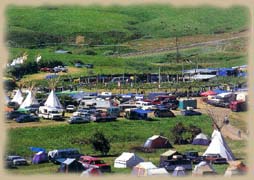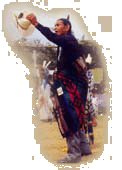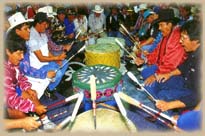History
by Chris Roberts
Definition
 Exactly when the modern day powwow began is difficult to pinpoint.
It certainly traces back over a hundred years and definitely has developmental periods.
Exactly when the modern day powwow began is difficult to pinpoint.
It certainly traces back over a hundred years and definitely has developmental periods.
Powwows do not limit themselves to dancing and singing "Indian" but is an overall term given to a social gathering of Indian people. With dancing as its primary focus, the powwow establishes itself as a celebration of culture. Besides dancing sessions many other events are scheduled into the four day time period over which a powwow takes place. Indian people gather to rodeo, gamble, honor relatives with giveaways, compete in athletic games and horse races, stage parades, schedule exhibition events and special ceremonies, feed friends and visitors, and buy goods at concession stands. However socializing is the prime attraction for all powwow participants.
Early History
According to Boye Ladd, Winnebago Fancy Dancer, "Songs and dances evolved around the imitation of animals and natural forces and were held sacred." The word powwow derives from the Algonquin definition of a coming together of medicine men and spiritual leaders in a curing ceremony, a ispauau or pau wau". When early European explorers observed these religious practices with the accompanying dances they mispronounced it "powwow" and believed it referred to any large gathering of Indian people. The term spread, and, as Indian tribes learned English, they accepted the definition given to their gatherings.
Historically, tribes in North America held summer ceremonies celebrating successful hunts, food gathering, or warfare. These ceremonies allowed people to give thanks, honor their deceased relatives, or deal with special honors such as name giving ceremonies, adoptions and coming of age rites. Often such ceremonies involved dancing and feasting.
These summer reunions took place at prearranged locations and dates. All tribal members would gather for social activities and religious ceremonies which reaffirmed the tribe's unity. Clans and societies held their annual rites. Cultural traditions strengthened. Today's powwow grew out of these religious and social dances of the plains tribes.
The history of the powwow as I learned it comes through my family from generation to generation. Our people would all come together once or twice a year for a celebration. There would be a big gathering of family and friends. There would be horse races and skill contests and at night everyone would dance. Families would host feasts and give-aways. All of this still goes on today. Wherever I go, I see Indian people being thanked for traveling to the powwow, camping out and visiting for days at a time."
Joe Sam Scabby Robe, Grass Dancer, Blackfeet
Plains Indian dancing was of three basic varieties: dream-cult dancing like the ill-fated Ghost Dance, vow fulfillment dances like the Sun Dance, and warrior society dancing. Contemporary powwow dancing is generally credited to the Hethuska (war dance) Societies of the Oklahoma Ponca, and the Omaha and Pawnee's "grass" dance." These two Nebraska tribes danced first with scalps attached to their belts and then switched to braided sweetgrass when the government discouraged intertribal warfare. The Pawnee gave the dance to the Omaha, who in turn gave the dance to the Sioux in the early 1870s. When the Indian wars ended, the warrior societies declined but the "Omaha grass dance" continued to exist. It became a social show dance in which the dancer concentrated on intricate body and head movements keeping his headdress feathers in constant motion.
Government Repression
From the time of the Indian Wars in the late 1800s both the U.S. and Canadian governments were afraid of Indian unity and did all they could to repress native culture and traditions. Indian people were rounded up and placed on reservations and restricted in their movements.
The Ghost Dance religion sprang up only to die a real and painful death at Wounded Knee, South Dakota. Indian language, culture and traditions were encouraged to die along with Big Foot and his band. In the 1890s, Indian dances and traditional ceremonies such as the Sun Dance were strictly forbidden.
Emergence
Oklahoma tribes were at the center of the powwow emergence. The Ponca Fair and Powwow originated in 1877. 1916 saw the beginnings of the Anadarko Fair. In 1925, the Haskell Institute in Lawrence, Kansas held a dance contest to determine the world's championship. The old Omaha grass dance was fancied up with colorful feathered bustles and fancy dancing was born. Indian people have always borrowed from each other and the new style of costuming and dancing quickly spread to other plains tribes.
Rejuvenation
Attitudes started changing in the late 1940s and early 1950s. World War II was over and many Indians were veteran "warriors". Clans and societies welcomed these patriots. Powwows were initiated to honor the veterans, a practice that continues to this day.
"The moderm day powwow can be traced to the Grass Dance societies that formed around the turn of the century. The Grass Dance is known by many different names among various tribes and has an interesting history. It can be traced back to the war dances and victory celebrations of an earlier era. Originally only experienced warriors could belong to Grass Dance societies."
Jonathan Windy Boy, Grass Dancer, Chippewa/Cree
Indian people look to their culture for strength and identity. This cultural awareness intensified during the 1960s civil rights movement when Indian people took a renewed pride in being Indian. The modern day proliferation of powwows is the strongest evidence of this cultural rejuvenation.
"Traditionally a powwow celebration was expressed through song and dance. However, a significant and often forgotten part of these get-togethers was the exchange of gifts. This practice was an important part of reestablishing old ties and friendships with each other. When a gift was given proper etiquette required that a gift be given in return. Throughout the years the powwow has evolved into a tradition exemplifying generosity and giving."
Jonathan Windy Boy, Grass Dancer, Chippewa/Cree


